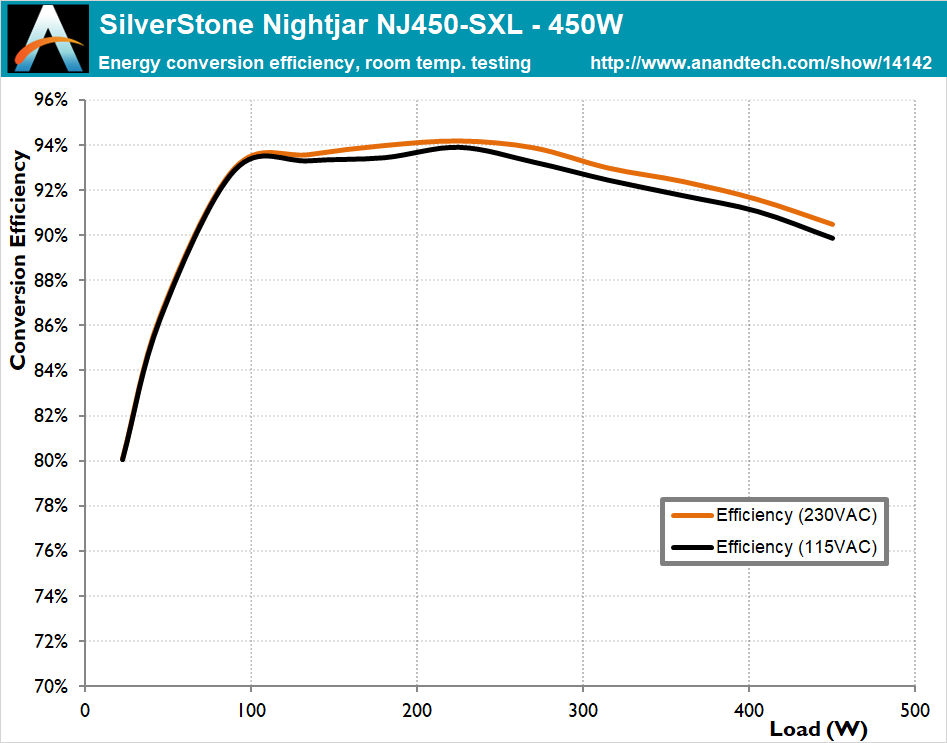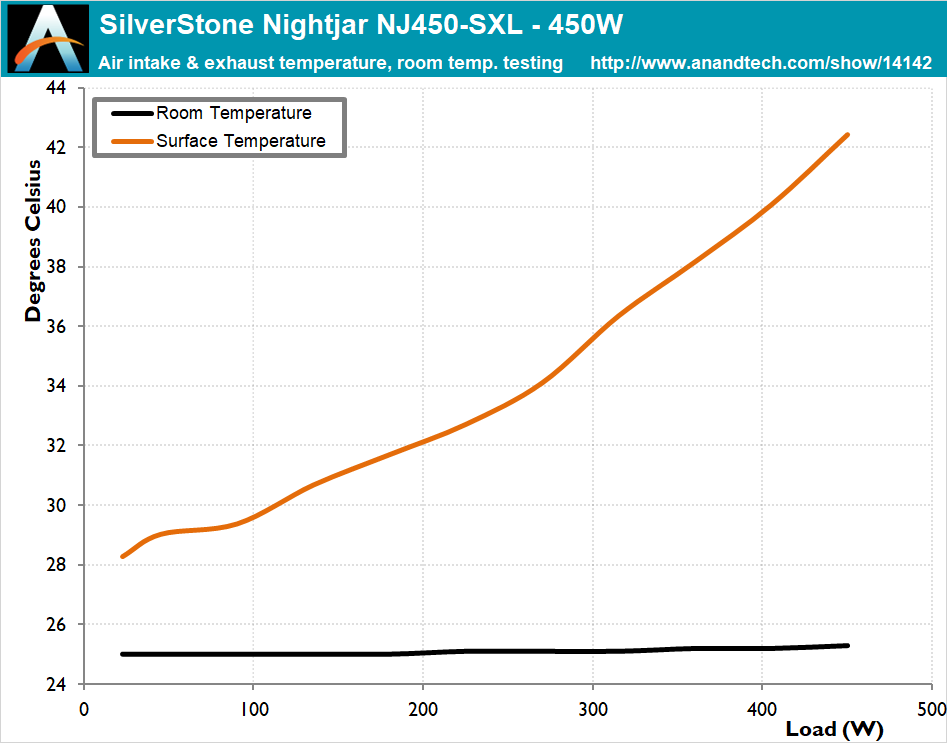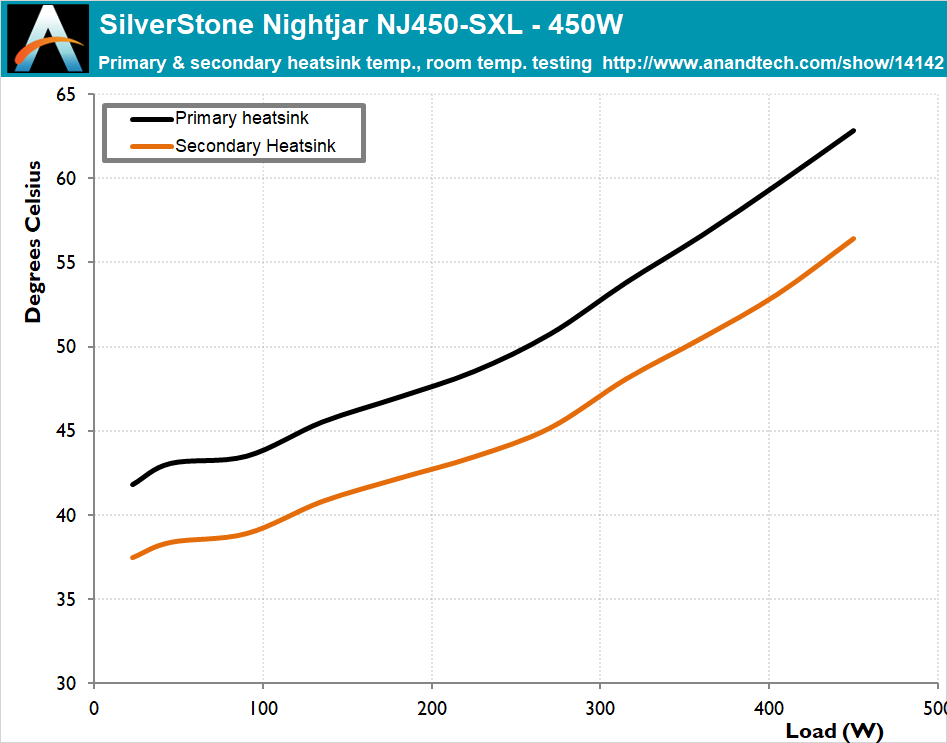The SilverStone Nightjar NJ450-SXL 450W SFX PSU Review: Passive Excellence
by E. Fylladitakis on April 4, 2019 8:00 AM EST- Posted in
- Cases/Cooling/PSUs
- PSUs
- SilverStone
- Passive Cooling
- SFX
- SFX-L
- Passive
Cold Test Results (Room Ambient Temperature)
For the testing of PSUs, we are using high precision electronic loads with a maximum power draw of 2700 Watts, a Rigol DS5042M 40 MHz oscilloscope, an Extech 380803 power analyzer, two high precision UNI-T UT-325 digital thermometers, an Extech HD600 SPL meter, a self-designed hotbox and various other bits and parts. For a thorough explanation of our testing methodology and more details on our equipment, please refer to our How We Test PSUs - 2014 Pipeline post.
Due to the unique thermal design of the Nightjar NJ450-SXL, we had to change our testing methodology quite a bit. As there is no airflow to assess, we placed a sensor on the bottom side of the chassis and measure its surface temperature instead. Note that these thermal results are not directly comparable with those obtained by testing regular air-cooled products.
The SilverStone Nightjar NJ450-SXL easily honors its 80Plus Platinum efficiency certification, significantly surpassing the minimum requirements of 92%/94%/90% efficiency at 20%/50%/100% load respectively (230V AC input). It has an average efficiency of 92.9% across its nominal load range, a relatively high figure even for an 80Plus Platinum certified unit. The efficiency drop when the unit is powered from a 115V AC source is small, reducing its average efficiency across the nominal load range down to 92.5%. Note that the efficiency drop is more severe at higher loads but negligible, or even negative, when the unit is very lightly loaded.
As expected from a well-designed passively cooled device, the surface temperature of its heatsink increases almost linearly and in near-perfect alignment with the unit’s thermal losses. It does reach over 40°C when the power supply is heavily loaded but that is a perfectly safe figure for an advanced PSU. The internal temperatures of the PSU over its primary and secondary side MOSFETs are acceptable, with the primary side getting a little bit hotter than the secondary side.














25 Comments
View All Comments
Death666Angel - Monday, April 8, 2019 - link
I have 2 monitors with interal power supplies that are caged by metal sheets and the only gap in that sheet are the power and display plugs. I can hear the whining noise very easily, once I move my head behind the monitor. In front of it, there is no noticeable noise (likely blocked by the display itself). But it is not that cut and dry.nagi603 - Monday, April 8, 2019 - link
Yeah, metal sheets are not good noise dampeners :DIcehawk - Thursday, April 4, 2019 - link
I have had one of these running 24-7 in my rig for about 7 years with no problems, have a higher wattage passive in my new box too. My PCs are very quiet with no PSU fans or mech HDDs. These are built to a high quality compared to a typical $50 PSU and is reflected in their cost.R3MF - Thursday, April 4, 2019 - link
i have a ~13 year old Nightjar 300W still running fine.Samus - Friday, April 5, 2019 - link
I've used a Seasonic X400 passive cooled PSU in my media PC (Silverstone ML03 case) for around 10 years. No problems at all. It started as an Intel i5-650 with a GeForce 430, then graduated to an AMD A10-9700, and is currently an i3-8100 still with the same GeForce 430 I used a decade ago because to me it makes a virtually perfect HTPC video card.The entire PC has always been passively cooled. A voltmod and BIOS flash to the EVGA GeForce 430 reduced its clock speed to 500MHz (1000MHz shader) and basically cut its TDP in half, allowing for a passive heatsink to be more than effective, and the CPU has used a NoFan CR-80eh cooler for most of this units life. The old Lynnfield CPU I used a Scythe Kozuti that needed modification to fit the motherboard\case by bending some heatpipes and the attached fins, which I broke removing it from the CPU when I upgraded (technically downgraded lol) the platform to an AMD A10. The A10 was a slower CPU but had much better thermal efficiency than the old i5, and the GPU was pretty good. The i3-8100 is absolutely perfect and the system has never run cooler. Total wall power draw during 1080p 24.976hz h264 video playback is 66 watts measured from a kill-a-watt and there are TWO SSD's and a 10TB HDD inside the case!
It's worth mentioning this is also my torrent PC so it is 24/7 albeit pretty low constant load.
All that said, the PSU and case have been through multiple generations of components.
DanNeely - Thursday, April 4, 2019 - link
As a general question, I'm wondering when we might start to see PSUs ship with only sata connector strings and a sata-molex adapter or two in the package similar to how the berg connector originally for the 3.5" floppy drive has been mostly done over the last decade.b1ghen - Thursday, April 4, 2019 - link
Probably never since the SATA connector isn't rated for enough current (1.5A I believe) and might melt if you hook up anything power hungry to the Molex in such a setup. A Molex can supply up to 13A i think. So a single Molex can supply 8x the current as a single SATA.daniel78R - Thursday, April 4, 2019 - link
I think S-ATA is 1.5A per pin, and if I remember well there are 3 pins for 3.3V, 3 for 5V and 3 for 12V, that would be 9.9w + 15w + 36w = 60.9V. Molex is 11A i think for 12V, 132w. However, the cables themselves are more important, also the specs of the PSU itself. I've seen PSUs with much less Amps per Molex or SATA rails. Also, I think some of my modular PSUs have the same port for SATA and Molex use on the PSU side.While Molex and Floppy connector might be needed for powering fans and such, I doubt you will ever use for powering anything close to 130w. AFAIK the most power hungry HDDs were about 10-12w
29a - Thursday, April 4, 2019 - link
Hopefully never. I'd much rather have them and not need them than need them and not have them.flyingpants265 - Tuesday, April 9, 2019 - link
What if they made them modular and let you select your own cables?